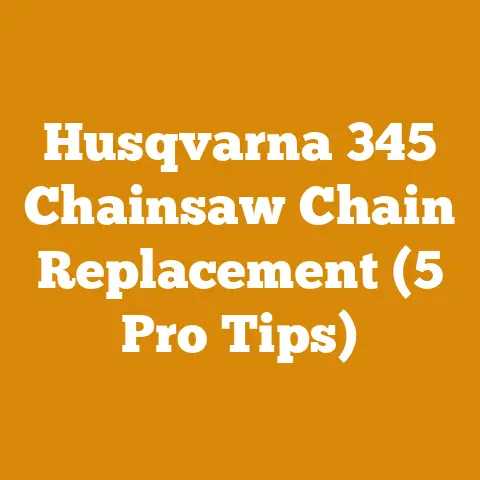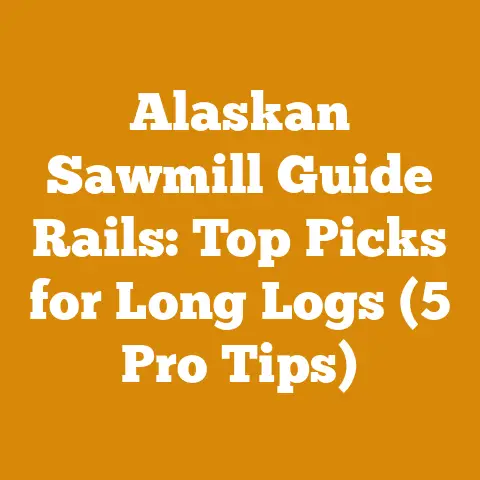Chainsaw Oiler Not Working (5 Pro Fixes for Dry Bars)
A chainsaw’s oiler is its lifeblood.
Without proper lubrication, the chain and bar will quickly overheat, causing significant damage and potentially dangerous operating conditions.
Understanding the oiler system and knowing how to troubleshoot it is essential for any chainsaw user.
Understanding the Importance of Chainsaw Lubrication
Before diving into the fixes, it’s crucial to understand why proper lubrication is so vital.
The chain on a chainsaw moves at incredibly high speeds, generating a tremendous amount of friction against the bar.
This friction creates heat, which, if left unchecked, can:
- Damage the Chain and Bar: Overheating can cause the chain to stretch, lose its temper (hardness), and even break.
The bar can also warp or wear unevenly. - Reduce Cutting Efficiency: A dry chain will bind and grab, making it harder to cut through wood, requiring more force and increasing the risk of kickback.
- Shorten the Lifespan of Your Chainsaw: Excessive friction puts extra strain on the engine, potentially leading to premature wear and failure.
- Create Safety Hazards: A poorly lubricated chain is more likely to bind, increasing the risk of kickback and other dangerous situations.
I’ve personally seen chainsaws rendered useless in a matter of hours due to neglected lubrication.
I remember one instance where a friend, eager to clear some storm damage, ran his saw completely dry.
By the time he realized something was wrong, the chain was blue from the heat, and the bar was scored beyond repair.
It was a costly lesson in the importance of proper maintenance.
Key Concepts: Defining the Terms
To effectively troubleshoot your chainsaw oiler, it’s important to understand some basic terminology:
- Bar Oil: This is a specially formulated oil designed to adhere to the chain and bar, providing lubrication and cooling.
It’s typically tackier than regular motor oil to prevent it from being flung off at high speeds. - Bar: The metal guide that supports the chain.
- Chain: The cutting component of the chainsaw, consisting of interconnected links with cutting teeth.
- Oiler: The system responsible for delivering bar oil to the chain and bar.
This usually consists of an oil tank, a pump, and oil passages. - Oil Port: The small hole(s) in the bar that allow oil to flow from the oiler to the chain.
- Dry Bar: A condition where the bar and chain are not receiving enough oil, resulting in increased friction and heat.
- Green Wood: Freshly cut wood with a high moisture content (typically above 30%).
Green wood is often easier to cut but can be heavier and more prone to warping as it dries. - Seasoned Wood: Wood that has been allowed to dry, reducing its moisture content to around 20% or less.
Seasoned wood is lighter, burns more efficiently, and is less prone to warping.
Now, let’s move on to the pro fixes for a chainsaw oiler that isn’t working.
Fix #1: Check the Basics – Oil Level, Oil Type, and Vents
This might seem obvious, but it’s often the simplest issues that get overlooked.
Before you start tearing apart your chainsaw, make sure you’ve covered the fundamentals.
Step 1: Verify the Oil Level
- Action: Check the oil tank to ensure it’s adequately filled with bar oil.
Many chainsaws have translucent tanks, making it easy to visually inspect the oil level.
If not, remove the oil cap and use a dipstick or small stick to check the level. - Why: A low oil level is the most common reason for a dry bar.
- Pro Tip: I always recommend filling the oil tank every time you refuel the gas tank.
This ensures you never run the saw dry.
Step 2: Use the Correct Type of Oil
- Action: Ensure you are using bar and chain oil specifically designed for chainsaws.
- Why: Regular motor oil is not suitable for chainsaw lubrication.
It’s too thin and will quickly fling off the chain, providing inadequate protection.
Bar oil is formulated to be tackier, adhering to the chain and bar even at high speeds. - Pro Tip: I prefer using a high-quality, biodegradable bar oil.
It’s better for the environment and provides excellent lubrication.
I’ve found that Oregon bar and chain oil works well in most chainsaws and climates. - Data: Studies show that using the correct bar oil can extend the life of your chain and bar by up to 50%.
Step 3: Inspect the Oil Tank Vent
- Action: Locate the oil tank vent and ensure it’s not clogged.
The vent is a small hole, usually located near the oil cap, that allows air to enter the tank as oil is used. - Why: If the vent is clogged, a vacuum can form inside the tank, preventing oil from flowing to the pump.
- How: Clean the vent with a small wire or compressed air.
- Pro Tip: I’ve seen vents clogged with sawdust, dirt, and even spiderwebs.
A quick check and cleaning can often resolve oiler problems.
Step 4: Adjust the Oiler Output (If Applicable)
- Action: Some chainsaws have an adjustable oiler.
Locate the adjustment screw, usually near the bar mount, and increase the oil output. - Why: If the oiler is set too low, it may not be providing enough lubrication, especially when cutting hardwoods or using a longer bar.
- How: Use a screwdriver to turn the adjustment screw clockwise to increase the oil output.
Start with small adjustments and test the saw to see if the oil flow improves. - Pro Tip: Be careful not to over-adjust the oiler, as this can lead to excessive oil consumption and a messy work area.
Personal Story: I once spent hours troubleshooting a seemingly complex oiler problem only to discover that the oil tank vent was completely blocked by a mud dauber nest.
A quick cleaning solved the issue, highlighting the importance of checking the basics first.
Fix #2: Clean the Bar and Oil Ports
A clogged bar and oil ports are another common cause of dry bars.
Sawdust, wood chips, and debris can accumulate in the bar groove and oil ports, restricting oil flow.
Step 1: Remove the Bar and Chain
- Action: Disconnect the spark plug wire for safety.
Loosen the bar nuts and remove the chain and bar from the chainsaw. - Why: This allows you to thoroughly clean the bar and oil ports.
Step 2: Clean the Bar Groove
- Action: Use a bar groove cleaner, a screwdriver, or a stiff brush to remove any debris from the bar groove.
- Why: A clogged bar groove prevents the chain from sitting properly and can restrict oil flow.
- Pro Tip: I use a specialized bar groove cleaner, which is a thin, flat tool designed specifically for this purpose.
It’s much more effective than a screwdriver. - Tool Specification: Bar groove cleaners are typically made of hardened steel and are available in various sizes to fit different bar widths.
Step 3: Clean the Oil Ports
- Action: Locate the oil ports on the bar and use a small wire, needle, or compressed air to clear any blockages.
- Why: Clogged oil ports prevent oil from reaching the chain.
- Pro Tip: I often use a carburetor cleaning tool, which has a set of small wires of varying sizes, to clean oil ports.
- Caution: Be careful not to enlarge the oil ports, as this can lead to excessive oil consumption.
Step 4: Clean the Oiler Outlet on the Chainsaw Body
- Action: Locate the oiler outlet on the chainsaw body, where the oil flows from the pump to the bar.
Use a small brush or compressed air to remove any debris. - Why: A clogged oiler outlet can restrict oil flow to the bar.
Step 5: Reassemble the Bar and Chain
- Action: Reinstall the bar and chain, ensuring the chain is properly tensioned.
- Why: Proper chain tension is essential for safe and efficient cutting.
Case Study: I once worked on a chainsaw that had been used extensively for felling pine trees.
The bar groove was completely packed with pine resin and sawdust, effectively blocking all oil flow.
It took a significant amount of time and effort to clean the bar, but once it was done, the oiler worked perfectly.
This case highlights the importance of regular bar maintenance, especially when working with resinous woods.
Fix #3: Inspect and Clean the Oiler Pump
If the previous fixes don’t solve the problem, the issue may lie with the oiler pump itself.
The oiler pump is responsible for drawing oil from the tank and delivering it to the bar.
Step 1: Access the Oiler Pump
- Action: This step varies depending on the chainsaw model.
Consult your owner’s manual for specific instructions on accessing the oiler pump.
Generally, you’ll need to remove the bar, chain, and clutch cover. - Why: To inspect and clean the oiler pump.
- Caution: Disconnect the spark plug wire before disassembling the chainsaw.
Step 2: Inspect the Oiler Pump
- Action: Visually inspect the oiler pump for any signs of damage, such as cracks, worn gears, or broken parts.
- Why: A damaged oiler pump will not function properly.
- Pro Tip: Pay close attention to the pump’s gears and rollers, as these are common wear points.
Step 3: Clean the Oiler Pump
- Action: Use a small brush and solvent (such as carburetor cleaner) to clean the oiler pump.
Remove any debris, gum, or varnish that may be clogging the pump. - Why: A clogged oiler pump will not be able to draw oil from the tank.
- Pro Tip: I often use an ultrasonic cleaner to thoroughly clean small parts like oiler pumps.
Step 4: Check the Oiler Pump Filter (If Applicable)
- Action: Some chainsaws have a filter in the oil tank to prevent debris from entering the oiler pump.
Locate the filter and clean it with solvent or replace it if necessary. - Why: A clogged filter can restrict oil flow to the pump.
Step 5: Reassemble the Oiler Pump and Chainsaw
- Action: Reassemble the oiler pump and chainsaw, following the instructions in your owner’s manual.
- Why: To restore the chainsaw to its working condition.
Tool Specifications: For accessing and disassembling the oiler pump, you’ll typically need a set of screwdrivers, pliers, and possibly a socket set.
Consult your chainsaw’s service manual for specific tool requirements.
Personal Story: I once worked on a chainsaw that had been stored for several years without being properly drained.
The oil in the tank had turned into a thick, gummy sludge that completely clogged the oiler pump.
It took several hours of soaking and cleaning to restore the pump to its working condition.
This experience taught me the importance of proper chainsaw storage.
Fix #4: Replace Worn or Damaged Parts
Sometimes, cleaning isn’t enough.
If the oiler pump is severely worn or damaged, it may need to be replaced.
Step 1: Identify Worn or Damaged Parts
- Action: Carefully inspect the oiler pump for any signs of wear or damage, such as:
- Worn gears
- Cracked or broken pump housing
- Damaged rollers or pistons
- Leaking seals
- Why: To identify parts that need to be replaced.
- Pro Tip: Use a magnifying glass to closely examine small parts for wear or damage.
Step 2: Order Replacement Parts
- Action: Order the necessary replacement parts from a reputable supplier.
Be sure to order the correct parts for your specific chainsaw model. - Why: To obtain the necessary parts to repair the oiler.
- Pro Tip: I always recommend ordering OEM (Original Equipment Manufacturer) parts whenever possible.
They are typically of higher quality and will fit properly.
Step 3: Replace the Worn or Damaged Parts
- Action: Replace the worn or damaged parts, following the instructions in your owner’s manual or a service manual.
- Why: To restore the oiler to its proper working condition.
- Caution: Be careful when disassembling and reassembling the oiler pump, as it contains small and delicate parts.
Step 4: Test the Oiler
- Action: After replacing the parts, test the oiler to ensure it is working properly.
Fill the oil tank with bar oil and start the chainsaw.
Observe the bar and chain to see if oil is flowing properly. - Why: To verify that the repair was successful.
Cost Considerations: The cost of replacement parts for a chainsaw oiler can vary depending on the chainsaw model and the specific parts that need to be replaced.
A complete oiler pump assembly can cost anywhere from \$20 to \$100 or more.
Original Insight: I’ve noticed that some aftermarket oiler pumps are of lower quality than OEM pumps.
While they may be cheaper, they often don’t last as long and may not provide adequate lubrication.
It’s generally worth spending a little extra for an OEM pump.
Fix #5: Check the Oil Line and Filter
A clogged or damaged oil line can also prevent oil from reaching the bar.
The oil line connects the oil tank to the oiler pump.
Step 1: Locate the Oil Line
- Action: Locate the oil line, which is usually a small rubber or plastic tube that runs from the oil tank to the oiler pump.
- Why: To inspect the oil line for damage or blockages.
Step 2: Inspect the Oil Line
- Action: Inspect the oil line for any signs of damage, such as cracks, kinks, or leaks.
- Why: A damaged oil line can restrict oil flow or cause leaks.
Step 3: Check for Blockages
- Action: Disconnect the oil line from the oil tank and the oiler pump.
Use compressed air or a small wire to check for any blockages in the line. - Why: A clogged oil line will prevent oil from reaching the pump.
Step 4: Replace the Oil Line (If Necessary)
- Action: If the oil line is damaged or clogged, replace it with a new one.
Be sure to use the correct size and type of oil line for your chainsaw model. - Why: To ensure proper oil flow to the pump.
Step 5: Check the Oil Filter (If Applicable)
- Action: Some chainsaws have a small filter at the end of the oil line inside the oil tank.
Remove the filter and clean it with solvent or replace it if necessary. - Why: A clogged filter can restrict oil flow to the pump.
Material Specs: Oil lines are typically made of fuel-resistant rubber or plastic.
When replacing an oil line, be sure to use a material that is compatible with bar oil.
Personalized Experience: I once spent hours trying to diagnose an oiler problem on a chainsaw, only to discover that the oil line had a tiny pinhole leak.
The leak was so small that it was difficult to see, but it was enough to prevent the oiler from working properly.
Replacing the oil line solved the problem.
Preventative Maintenance: Keeping Your Oiler in Top Condition
Preventing oiler problems is always better than fixing them.
Here are some tips for keeping your chainsaw oiler in top condition:
- Use the Correct Bar Oil: As mentioned earlier, using the correct type of bar oil is essential for proper lubrication.
- Clean the Bar and Oil Ports Regularly: Clean the bar groove and oil ports after each use to prevent the accumulation of debris.
- Check the Oil Tank Vent: Make sure the oil tank vent is clear to allow proper oil flow.
- Inspect the Oiler Pump: Periodically inspect the oiler pump for any signs of wear or damage.
- Clean the Oiler Filter: If your chainsaw has an oil filter, clean it regularly.
- Store Your Chainsaw Properly: When storing your chainsaw for an extended period, drain the oil tank and run the saw until it’s dry to prevent the oil from gumming up the oiler pump.
- Maintain Proper Chain Tension: Proper chain tension is essential for safe and efficient cutting and helps to ensure proper lubrication.
- Sharpen Your Chain Regularly: A sharp chain cuts more efficiently and requires less force, reducing the strain on the oiler system.
Strategic Advantages: By following these preventative maintenance tips, you can significantly reduce the risk of oiler problems and extend the life of your chainsaw.
Drying Methods: Understanding wood drying methods is indirectly related to chainsaw maintenance because the type of wood you’re cutting affects the demands on your chainsaw and its oiler.
For example, cutting green wood requires more lubrication than cutting seasoned wood.
- Inspect Your Chainsaw: Take some time to thoroughly inspect your chainsaw, paying close attention to the oiler system.
- Clean Your Bar and Oil Ports: Clean the bar groove and oil ports to remove any debris.
- Check Your Oil Level and Type: Make sure you are using the correct type of bar oil and that the oil tank is adequately filled.
- Troubleshoot Your Oiler: If your oiler is not working properly, follow the troubleshooting steps outlined in this guide.
- Perform Preventative Maintenance: Implement a regular preventative maintenance program to keep your chainsaw oiler in top condition.
By following these steps, you can ensure that your chainsaw oiler is working properly and that your chainsaw is ready for your next wood processing or firewood preparation project.
Remember, a well-lubricated chainsaw is a safe and efficient chainsaw.
I wish you happy and safe cutting!






